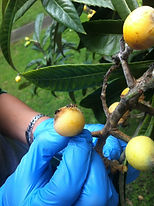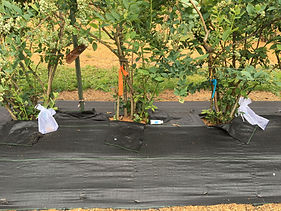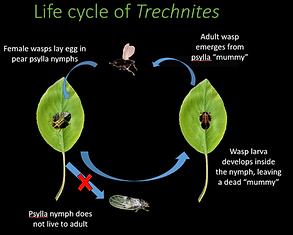
Dalila Rendon, Biologist
Current research:
Ecology and management of aphid virus vectors in blueberry. With the arrival of an unstudied virus complex in Pacific Northwest blueberries, we are trying to understand the role of aphids as vectors in transmission. How effective are they? when is infection more likely to happen?
The blueberry aphid Ericaphis fimbriata
Automated visual recognition of insect pests in traps using machine learning. Processing traps and counting insects is a tedious, time-consuming process. To facilitate these tasks, I build image databases of trap contents, and train deep learning models to automatically recognize and count specific insect pests, particularly Spotted-Wing drosophila. I previously collaborated in a project with University of California Integrated Pest Managment Extension service to create an automated visual recognition system for chatbot users who need to identify insects based on pictures they take.
Past research:
Foraging strategies on predatory mites. We determined the parental and grandparental effects of predation learning in the predatory mite A. swirskii.
-
Publications:
Integrated pest management of pear psylla. How can we use landscape ecology, phenology, pesticide use, and conservation biological control to suppress pest psylla?
-
Publications (first author and coauthored):
-
Press articles:
Excessive honewdew secreted by pear psylla makes orchards sticky and prone to diseases
Life cycle of Trechnites insidiosus, an important parasitoid of pear psylla
Efficacy of organic insecticidal baits and oviposition deterrents for the control of Spotted-wing drosophila in cherry orchards. In collaboration with local growers and chemical companies, we assesed the efficacy of insecticidal and oviposition baits for Spotted-wing drosophila in cherry orchards.
-
Publications (first author and coauthored):
-
Press articles:
Cultural control of Spotted-wing drosophila (Drosophila suzukii) in blueberry. We investigated how cultural control methods such as incorporating weed mats or different irrigation systems influence the survival of Spotted-wing drosophila in commercial fields. This is a multi-region collaborative project with multiple universities accross the United States.
-
Publications (first author and coauthored):
-
Cultural Control of Drosophila suzukii in Small Fruit—Current and Pending Tactics in the U.S.
-
Mulching as a cultural control strategy for Drosophila suzukii in blueberry.
Bags with infested blueberries placed on weedmats in a blueberry field
Overwintering ecology, physiology and nutrition of Spotted-wing drosophila. Part of the invasive potential of the Spotted-wing drosophila is attributed to its ability to survive winters as adults, and quickly colonize agricultural areas and infest fruit in spring. My research aims to understand the nutritional and environmental parameters during winter and spring that optimize survival and oviposition. Additionally, we monitor the presence of Spotted-wing drosophila in wild, unmanaged areas and their use of wild fruit as hosts.
-
Publications (first author and coauthored):
Winter morphs of wild Spotted-wing drosophila females collected in early spring. The female on the right has fully mature eggs.
Susceptibility to natural predators in irradiated and wild Queensland fruit flies. As part of the Sterile Insect Technique (SIT) method for the control of the Queensland fruit fly, flies are mass-reared and then irradiated to render them sterile, before being mass-released in the wild. As irradiated males need to outcompete wild males to mate with females, it is necessary to determine whether the rearing and irradiation process affects antripredatory behavior of flies, making them more suceptible to mortality due to predation.
Queensland fruit fly laying eggs in loquat fruit
PhD research:
Gut-content molecular analysis of spiders in cotton crops
To determine whether wolf spiders hunt late instar cotton bollworm larvae (Helicoverpa armigera, a Noctuid moth) in the field, I applied molecular techniques to analyse the gut contents of field-collected spiders and test for the presence or absence of Helicoverpa armigera remains. This immunomarking method employs Enzyme-linked immunosorbent assay (ELISA) on bollworms that have been previously tagged with an IgG protein marker
-
Publications:
Predator-prey interactions between wolf spiders and cotton bollworms
I have studied the predatory behavior or two species of wolf spiders that are common in cotton fields (Tasmanicosa leuckartii and Hogna crispipes), and how effective are these spiders at hunting cotton bollworm larvae (Helicoverpa) after they decend from the plant to pupate underground, as well as newly emerged moths.
-
Publications:
Food webs on cotton grounds: who eats whom and why?
Because trophic webs are never straightforward, I am interested in understanding how multiple predators and prey items influence whether wolf spiders hunt cotton bollworms. Does the presence of alternative prey items (i.e., the ground cricket Teleogyllus sp.) interfere with wolf spiders hunting cotton bollworms? Does intraguild predation between wolf spiders limits the biological control exerted on cotton bollworms? Is it possible to link interactions between multiple predators and prey with their nutritional balance?
-
Publications:
-
Does prey encounter and nutrient content affect prey selection in wolf spiders inhabiting Bt cotton fields?
-
Multiple intraguild predators reduce mortality risk of a mutual agricultural pest prey in simple, but not in complex, experimental settings.
Spider biodiversity in minimum-tillage cotton
Minimum-tillage is a cotton cropping practice where fields are not deeply ploughed after harvest, and the plant material is retained on the soil. It started as an agronomic strategy to retain soil moisture and improve nutrient cycling, but now we are also observing how it can contribute to integrated pest management (IPM). Since minimum-tilled fields experience less disturbance and have more plant complexity, they can also provide refuges to enhance the diversity and richness of ground spider species.
-
Publications:








Male of Tasmanicosa leuckartii, a common spider in cotton fields in Australia, and voracious predator that also hunts the cotton bollworm (Helicoverpa armigera)

A cotton bollworm (Helicoverpa armigera), dyed for my behavioral experiments

One of the 12 species of wolf spiders found in the fields at the Australian Cotton Research Institute

Hogna crispipes eating a 5th instar Helicoverpa armigera larva